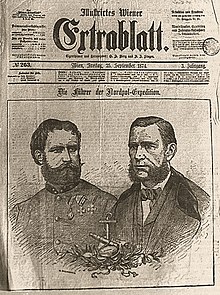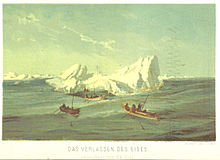Austro-Hungarian North Pole Expedition

The Austro-Hungarian North Pole Expedition (from Julius Payer Austro-Hungarian North Pole Expedition and popularly also called Payer-Weyprecht Expedition ) started in 1872 under the direction of Carl Weyprecht and Julius Payer and ended in 1874. It was initiated and financially supported by Count Hans Wilczek carried out to explore the Arctic Ocean more closely. Friedrich Schey von Koromla was one of the other financiers . The crew of the expedition was recruited from all over Austria-Hungary, but especially from Istria and Dalmatia .
Course of the trip
The expedition ship Admiral Tegetthoff was a sailing ship with an auxiliary engine and left the Norwegian port of Tromsø with a crew of 24 in July 1872 . At the end of August, it got stuck in the ice north of Novaya Zemlya at 79 ° 51 ′ and was driven off in polar regions known only to seal hunters and whalers. On this drift, the expedition discovered on August 30, 1873 the group of islands known only to a few Norwegian fishermen as Rönnebeck Land , which they named " Franz-Josef-Land " after Emperor Franz Joseph I. the first island the expedition set foot on was named Wilczek Island after its sponsor Count Wilczek . Researchers went on numerous sleigh trips and expeditions on foot on the archipelago to map the area. The expedition members spent two winters on board the trapped ship.
In the spring of 1874, the expedition leadership decided to leave the ship behind in the pack ice and set up mobile accommodation and short-term observation stations further north. While the rest of the crew stayed on board, Payer and some companions made their way north to reach the 82nd parallel and break the almost 50-year-old record of the British polar explorer James Clark Ross , because at this point it was not yet announced that Francis Hall had set a new record in 1871. After a march of 17 days, Payer and his companions, ship ensign Eduard Orel and sailor Antonio Zaninovich, reached the northernmost point of the archipelago at 81 ° 50 ′ north latitude on April 12, 1874 and named it Cape Fligely . Then they had to walk 300 km back to the ship. Payer has covered more than 800 km on the archipelago.
A few days after Payer's return, the expedition left the Tegetthoff on May 20 and began the return journey across the ice on sledges and boats. Five of the boats were packed on sleds. All instruments, all the records that Weyprecht and his officers made during the two-year stay in the ice were packed waterproof and shockproof. The sledges were pulled over the ice and snow wilderness, furrowed by countless blocks, bumps, cracks and crevices, only to find after weeks that unfavorable winds from the south had carried the ice masses - and with them the tired crew - back again. So on July 15th they were almost at the height of the abandoned ship and could even see it. Some, in their panic and desperation, wanted to get back on board in order to end their lives. Weyprecht managed, however, to persuade the drained, starving and demoralized crew with the Bible in hand to march southwards to save them. Payer later held back this scene in the monumental oil painting Never! , which is now in the Army History Museum in Vienna.
After a month of marching south, the ice drift stopped in the meantime, the expedition finally reached the open sea on August 14, 1874. In addition, there was a bit of luck, because the ice line had moved far north that year. After six days of rowing, they were taken on board by two Russian transchoners who were engaged in salmon fishing and reindeer hunting on the coast of Novaya Zemlya in the mouth of the Puhova River, and after tough negotiations (the fishermen should have three boats, two Lefaucheux- Rifles and 1200 silver rubles received) to the Norwegian port of Vardø .
On September 25, 1874, the expedition team, which had lost only one member, Otto Krisch , to illness and death, arrived in Vienna at the north station and was cheered on the journey to the city center: the wagons could only advance step by step from the north station […] reach. […] It is not exaggerated to assume that a quarter of a million people attended the reception.
Julius Payer was subsequently raised to the hereditary nobility by Emperor Franz Joseph I.
Late arrival of the message in a bottle
In 1874, when he persuaded the crew to persevere, Carl Weyprecht wrote a message in a bottle in which he described the events, and at this point also handed it over to the sea. This bottle was found 104 years later in 1978 by a Russian explorer, Vladimir Serov, on the island of Lamont in Franz Josef Land. It came to Vienna through diplomatic channels in 1980 and is now owned by the Austrian Academy of Sciences .
Meaning of discovery
The land discovery and the experiences of the expedition were an essential contribution to polar research, especially to the discovery of the Northeast Passage by Adolf Erik Nordenskiöld . They also kicked off the International Polar Years . This paved the way from the sporting race of individual expeditions to worldwide scientific cooperation in the exploration of the polar regions. In addition, Payer / Weyprecht had set foot on the northernmost point of Eurasia for the first time with Cape Fligely and refuted the theory of the ice-free Arctic Ocean with their expedition .
The scientific results of the North Pole expedition (meteorological, astronomical, geodetic, magnetic and polar light observations as well as zoological results) were published in 1878 in a memorandum of the Academy of Sciences . In addition, Julius Payer wrote the work Austro-Hungarian North Pole Expedition in the years 1872–74 , published in 1876, and created paintings , the only ones that a polar explorer has ever painted himself from his expedition. The best known is the picture Never Go Back! ; It shows how the expedition leaders prevented the sailors from returning to the abandoned ship after the failure of the first, extremely laborious attempt to march back, and instead encouraged a second, ultimately successful, attempt.
The expedition was processed in terms of literature in Christoph Ransmayr's novel The Horrors of Ice and Darkness .
Museum reception
The Austro-Hungarian North Pole expedition is documented in detail in the marine hall of the Vienna Army History Museum . On display are numerous paintings by Julius Payer, including the monumental painting Never Back , which reflects the drama of the situation when the crew wanted to return to the ship trapped in the ice, which would have meant certain death. There are also models of ships on display that relate to the expedition and Julius von Payer's famous “snake”. These are reflections that Payer put on paper shortly before his death and that tell about his life. The pieces of paper were later glued together and resulted in a total of 24 rolls, which were labeled "The Snake". Several photographs also illustrate what is happening.
Honors
In Vienna, the Nordpolstrasse (since 1875) in the 2nd district of Leopoldstadt , the Payergasse (since 1876) and the Weyprechtgasse (since 1875) in the 16th district of Ottakring and the Julius-Payer-Gasse in the 22nd district of Donaustadt commemorate the expedition and theirs Ladder. Wilczekgasse in the 10th district of Favoriten has been a reminder of the financier of the expedition, Count Hans von Wilczek, since 1932 . There is also a Payergasse and a Weyprechtgasse in Mödling , to the north of which is the Gasthaus zum Nordpol . The Vega-Payer-Weyprecht barracks of the armed forces are also located in the 14th district . There is a Payer-Weyprecht-Straße in Graz .
Franz Magenschein signposted his tavern, located on the Kaiserwasser, an arm of the Danube, from which one could watch the rowers on the Old Danube , in 1874 in honor of the polar explorer Franz-Josef-Land ; In 1876 the surrounding, no longer existing alluvial forest on the Kagraner Reichsstraße (today's Wagramer Straße), in which the inn facing the North Pole was located, was named like this and developed into a "small Prater ".
In Wiener Neustadt there is also a Weyprechtgasse and a Krischgasse running across it.
The two field camps set up as part of the Mars2013 field simulation were named “Camp Weyprecht” and “Station Payer”.
Individual evidence
- ↑ Quoted from Ransmayr, p. 254, from: Die Nordpolfahrer in Wien. (…) The Commune had (…) for those arriving. In: Neue Freie Presse , Morgenblatt, No. 3622/1874, September 26, 1874, p. 6, center left. (Online at ANNO ). .
- ^ Carl Weyprecht exhibition ( Memento from August 11, 2015 in the Internet Archive ) accessed on November 5, 2011
- ↑ Weyprecht exhibition ( memento of September 23, 2015 in the Internet Archive ) (PDF; 108 kB) Flyer for the 125th anniversary of Weyprecht from 2006, accessed on October 5, 2011
- ^ Army History Museum / Military History Institute (ed.): The Army History Museum in the Vienna Arsenal . Verlag Militaria , Vienna 2016, ISBN 978-3-902551-69-6 , p. 159
- ^ Felix Czeike : Historical Lexicon Vienna. Volume 2: De-Gy. Kremayr & Scheriau, Vienna 1993, ISBN 3-218-00544-2 , p. 369; Illustration of Magenschein's inn in: Edith Mühlbauer, Mathilde Lengheim, Josef Stupka, Klaralinda Ma-Kircher (Red.): 22 - District Museum Donaustadt. Wiener Geschichtsblätter , supplement 3.2005, ZDB -ID 43529-6 . Association for the History of the City of Vienna (publisher), Vienna 2005, p. 25.
- ↑ Blog entry of the Austrian Space Forum from February 18, 2013, English
- ↑ MARS2013 ended successfully ( Memento from October 11, 2014 in the Internet Archive ) Press release on the conclusion of the Mars2013 project
literature
- Julius Payer, Carl Weyprecht: Austrian-Hungarian North Pole Expedition. 1872 to 1874. In: M (oritz) A (lois) Becker (Red.): Mittheilungen der kk Geographische Gesellschaft Wien. Volume 17.1874. Verlag der Gesellschaft, Vienna 1874, pp. 389–417. - Full text online .
- Julius Payer: The Austro-Hungarian North Pole Expedition in the years 1872–1874, together with a sketch of the second German North Pole expedition 1869–1870 and the polar expedition of 1871 , Alfred Hölder, Vienna 1876.
- Frank Berger: Julius Payer. The unexplored world of mountains and ice. Tyrolia-Verlag, Innsbruck / Vienna 2015, ISBN 978-3-7022-3441-6 .
- Enrico Mazzoli and Frank Berger: Eduard Ritter von Orel (1841-1892) . Trieste 2010, ISBN 978-88-96940-38-9 .
- Manfried Rauchsteiner : The Payerschlange. The mysterious notes of an aging genius. In: Viribus Unitis. Annual report 2000 of the Army History Museum , Vienna 2001, pp. 9–40.
- Christoph Höbenreich: Expedition Franz Josef Land. On the trail of explorers to the north . Expedition picture book about the Payer-Weyprecht-Gedächtnexppedition 2005, the Austro-Hungarian north polar expedition 1872–1874, the polar journey of the icebreaker Kapitan Dranitsyn 2006 and a comprehensive expedition chronicle. Frederking and Thaler Verlag, Munich 2007, ISBN 978-3-89405-499-1 .
- Ursula Rack: Socio-historical study on polar research based on German and Austro-Hungarian polar expeditions between 1868-1939. In: Reports on polar and marine research . Volume 618.2010, ISSN 1618-3193 . Alfred Wegener Institute for Polar and Marine Research, Bremerhaven 2010. - Full text online (PDF) .
- Johan Schimanski and Ulrike Spring: passengers of the ice. Polar heroes and arctic discourses 1874. Böhlau Verlag, Vienna 2015, ISBN 978-3-205-79606-0 .
- Andreas Pöschek: The Addiction to the North Pole - The Austro-Hungarian North Pole Expedition 1872–1874 ( Memento from July 6, 2011 in the Internet Archive ), Vienna 2000
- Christoph Ransmayr : The horrors of ice and darkness . Christian Brandstätter Verlag & Edition, 1984, ISBN 3-85447-043-6 .
Movie
- The Ice Trap - The Tegetthoff's Arctic Odyssey. Elisabeth Guggenberger (book), Helmut Voitl (director). Docu-drama. 3sat, 2003.



